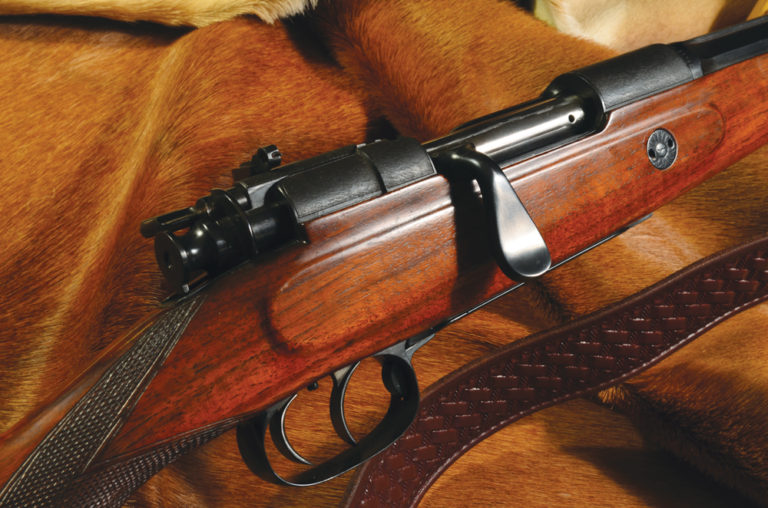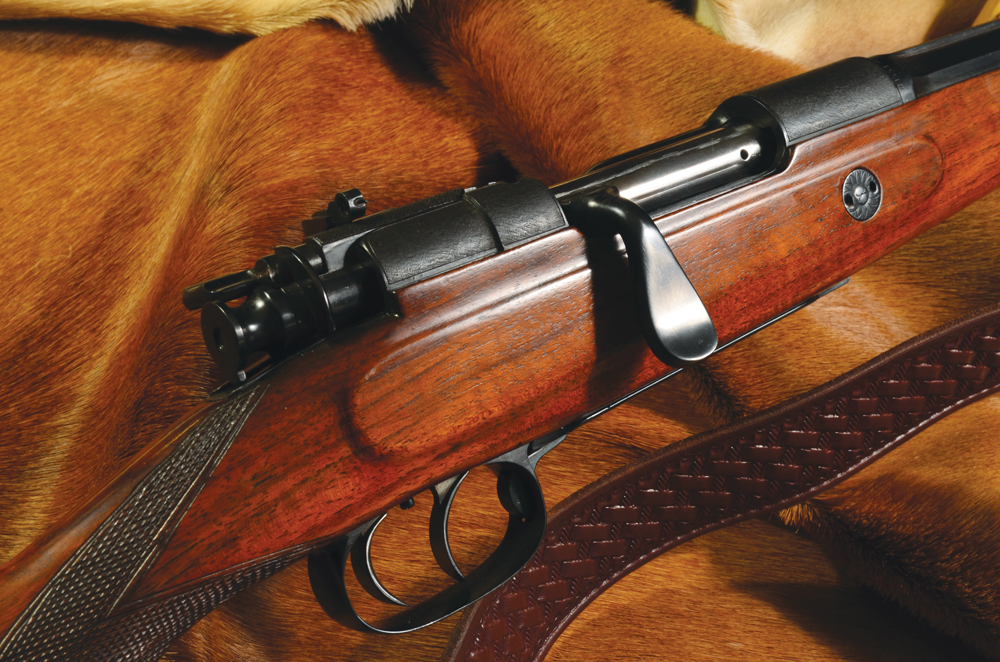

In the years before 1914 one could find, tucked away in a corner of the Sears, Roebuck catalog, a listing for a bolt-action sporting rifle from Germany. Variously listed as a Mannlicher, or a Haenel-Mannlicher, or sometimes just a C.G. Haenel (pronounced HY-nul), these rifles were the first steps in a trend that became a deluge: Bolt-action sporting rifles based on military actions.
Generally now known as Haenel-Mannlichers, these German bolt-action rifles were not cheap. In the 1902 Sears catalog, the price was $24.50. By comparison, a Winchester Model 95 listed at only $17.50. What made the German import worth 50 percent more than this state-of-the-art lever rifle? And why, when Model 95s are prized by collectors, are Haenel-Mannlichers all but forgotten except for a few devotees of early custom rifles?
There are two answers to that question, and relative quality has nothing to do with it. They are both finely made rifles, and some of the Haenels especially so.
For most gun collectors, the era of sporting bolt rifles began with the Mauser 98.
Everything good and modern occurred after that, they believe, and nothing much before. But such was not the case. In the frenzy of rifle development in Europe between the arrival of smokeless powder in 1886 and the ultimate Mauser in 1898, several good military bolt rifles made their debut. For sporting purposes, the most significant by far was the German Commission rifle of 1888.
For military collectors, the Gewehr ’88 is almost a cult object, and while it has been widely written about, it is also widely misunderstood. It is sometimes described as a Mauser with Mannlicher features, and sometimes the reverse. In reality, however, the Commission rifle was neither Mauser nor Mannlicher, but that rarest of creatures: A mechanical device designed by committee that was highly successful.
Its stint as the official infantry rifle of the German Army was short-lived – only 10 years – but it went on to a successful career in every corner of the globe as both military rifle and, in its converted form, a hunting rifle. So good was the Commission action that Steyr, in Austria, which manufactured the ’88 under contract for Berlin, modified it into a hunting rifle. The result was the famous Mannlicher-Schönauer Model 1903, a design that set the standard for quality hunting rifles for the next 70 years.
Steyr was not the only company to appreciate the virtues of the Commission rifle. C.G. Haenel, a prominent German gunmaking company in Suhl, also made Commission rifles under contract. Founded by Carl Gottlieb Haenel in 1840, C.G. Haenel & Co. quickly became a force in German gunmaking and, like most German firms, produced sporting weapons when it was not filling military contracts.
Haenel’s civilian rifles on the Commission action followed the German hunting rifle style that existed since the advent of centerfire cartridges. Most had half-octagon barrels with full or partial matted ribs, matted receiver ring, folding leaf sights, schnabel fore-ends and elegant turned-down bolt handles. There was usually a stock-bolt in the fore-end, and sometimes they were fitted with receiver sights. Most had double-set triggers. While the majority were chambered for the standard military 8×57 cartridge (usually the original .318” bullet, rather than the later .323”) they were also offered in pure hunting cartridges like the 9×57.

The first importer of Haenel-Mannlichers was Oscar Hesse of New Jersey, who began bringing them into the U.S. in 1894. There was a strong connection between German shooting clubs in the U.S., German immigrant gunmakers and the German companies, so more and more importers got into the act, and each, it seemed, stipulated little changes to the overall design. As a result, the number of minor variations seems endless.
This brings us back to the two major reasons there is only minor collector interest in these rifles. The first, of course, is the lack of a famous name such as Winchester. The second is the impossibility of classifying rifles by model and year. Model classification and certifiable originality are the backbone of gun collecting, and with Haenel-Mannlichers and other civilian rifles based on the Commission action, this is almost impossible. There were too many importers at this end, too many small gunmakers at the other end, and far too many variations in between.
For the modern rifle lover though, Haenels in their many guises offer an opportunity to own a rifle of stellar quality for not much money. The materials, workmanship and finishing are comparable to fine, modern, custom rifles. On the negative side, they are chambered for cartridges like the 8×57 and 9×57 that by today’s standards are relatively low velocity and suitable only for short-range hunting.
Collecting Haenel-Mannlichers may never make you any money, but it can lead into exploration of a fascinating byway in the history of the sporting rifle. You will find early Mannlichers from Steyr as well as German and Austrian custom makers, and you will find custom-ordered takedown rifles and modified Gewehr ’88s.
There was life before the Mauser 98 and the evidence lies — as with so much of American life — in the pages of the old Sears, Roebuck wish book.
This article appeared in the 2016 Gun Digest annual.

Next Step: Get your FREE Printable Target Pack
Enhance your shooting precision with our 62 MOA Targets, perfect for rifles and handguns. Crafted in collaboration with Storm Tactical for accuracy and versatility.
Subscribe to the Gun Digest email newsletter and get your downloadable target pack sent straight to your inbox. Stay updated with the latest firearms info in the industry.









i have an old mauser in awesome shape could someone help me learn more about it. it has the eagles carrying a swastika the serial is 22651 I BYF 43 it has so many markings on it actually. it has the v sight and more . please nourse.brad@gmail.com is my email and/or you can text me at 518902015 pleasse and thank you
Given equally designed and mounted rifles and similar ammunition and BORE CONDITION, the 7.92X57 (8mm Mauser) will do about anything the .30-06 can do… stocks, barrel length, scopes, ammunition variables all figure into it… There are a lot more bullet designs of various weights made for the ’06 than are available for the 7.92X57.. European loads are far hotter and harder hitting than the rather anemic round-nose loads made in USA for the 8mm Mauser. A reason for this is that US ammunition makers fear the lawsuits that would follow if “S” bore (.323) Spitzer bullets were fired in the older unconverted “J”-bore Commission 88 rifles of the old “J” (.318) bore size. Most all the 88 “J”-bore Commission rifles were converted to “S”-bore size and have worked well enuff during and since ww1. (SOME German hunting rifles today are made with the old “J”- bore dimensions, but that doesnt concern us in the States).
There shouldnt be a problem, all the German conversions SHOULD have a prominent “S” stamped on the receiver. Modern European 7.92X57 “S”-bore ammo is kick-butt stuff, as was the German Army military ammunition. Czech Sellier & Bellot makes excellent high-power ammunition hunting ammunition for the “S”-bore 8mm Mausers, good for deer, bear and elk when fired from the modern K98k rifles.. Of course one can handload for the Mauser to get optimal performance from the 8mm “S” bore Mauser. That said use trustworthy data and follow all directions carefully and reload in safe conditions! The 7.92X57 is a powerful round when loaded correctly, but neither it nor the ’06 are magnum calibers, so follow directions!!
I use Sellier & Bellot 196gr SPCE for hunting with my old Mausers and mil-surp for plinking and banging around practice. Either will do what the ’06 will do. Eventually I intend to scope a nice Steyr Mauser 98 sporting conversion I bought a few years ago, someone did a real nice conversion- probably early post- war German, judging by the style of the stock and metal work.
If you have an old Mauser, don’t butcher it if it’s still in original shape. If you have one that’s been sporterised, don’t worry, it will shoot just as well as the modern sporters will, all things being equal..
I cannot understand how Von Mannlicher name could be associated with the gewehr M1888 since decades. In his entire life he didn’t design not even a single screw but he was a very very smart manager and director of Steyr factory OEWG.
The designer was Louis Schlegelmilch chief gunsmith of Spandau Arsenal who perfected the mauser M1871 bolt adding two locking lugs in front of it. Unfortunately he “stole” the Mannlicher patented en bloc clip so the cunning baron blackmailed the arsenal asking for the manufacturing and marketing license of the M1888 without royalties to grant the use of the magazine and clip. Otherwise lawsuit. Steyr M1893 rumanian and netherland mannlichers are just german 1888 with very minor modifications: barrel jacket removed, added rib on the bolt for better smoothness and slightly different ejector. The same the prized Mannlicher Schonauer: it actually should be named Schlegemilch Schoenhauer cause it has nothing to be named Mannlicher.
Suitable only for short range hunting? Well if you are talking 600 yard shots that the average hunter with his low skill level that has no business taking then the answer is yes. But for a truly skilled shooter the 8×57 is more than capable of knocking off non dangerous game at 600 yards not that I would take such a shot despite the fact that I have competed in NRA across the course events in their 3 position shooting. Why would I not when I am quite capable of doing so? Because I am a rare hunter, I respect the wild game I hunt and under field conditions too much can go wrong even if the hunter is a skilled shot. Although I have never been a big fan of the 8×57 there is absolutely nothing wrong with this cartridge as it is right up their with the ubiquitous 30-06. I do prefer the 7×57 any day over both of them.
I think when you look at the fantastic workmanship and quality of materials used to build the “Old fashioned” guns including the ubiquitous 98 Mauser sporting rifles you begin to see and understand what garbage is being built today. Yes the newer guns may shoot accurately but holding a piece of plasticky stocked junk made mostly of stamped sheet metal and junk castings its enough to make a brass monkey puke providing you are one of those rare “old time individuals” that actually understands what goes into the making of a quality firearm.
In conclusion old time “real hunters” understood wild game habits and used to actually stalk up to ranges as close as 25 yards. Modern hunters make statements like “I always blast away at 1,000 yards as it eliminates that sneaking up bit some people call hunting” Spoken like a true slob modern hunter.